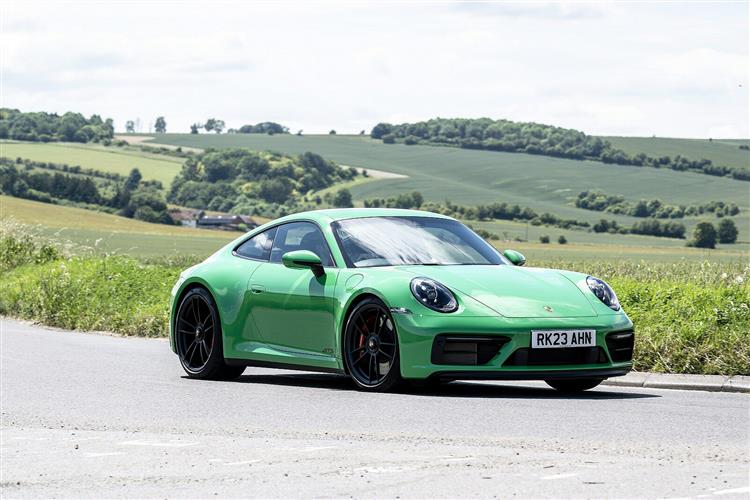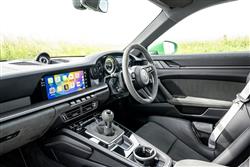THE GRAN TURISMO SPORT EFFECT (some text hidden) --NONE--
By Jonathan Crouch
Introductionword count: 80
Back in 2019, the original 992-era version of Porsche's 911 sportscar proved that this model line had plenty of life left in it. Proof of that came with this mid-level Carrera GTS model. With more focus than a base Carrera and just a taste of 911 Turbo, it might well be all the 911 you could ever need from the 2021-2024 era. Here's where we look at this 992 model from a used buyer's perspective and try to find out.
Modelsword count: 11
2dr sports Coupe / Cabriolet / Targa (3.0 Carrera & Carrera4)
Historyword count: 198
'GTS' or 'Gran Turismo Sport' branding has long been a Porsche staple. The company first used it back in 1963 with their 904, the moniker supposed to designate a sports car suitable for both road and track. GTS versions of the 924, 928 and Cayenne then eventually followed but the badge didn't appear on the 911 until 2009, as part of the facelift made to the '997' version of that model. Sales were strong enough for the GTS nomenclature to be retained for the replacement '991'-series 911 in 2012. In 2021, it also appeared on that car successor, the '992' series 911, creating the car we're going to look at here. Which was available with rear and all-wheel drive and with the Coupe, Targa and Cabriolet body styles. The idea with the 911 GTS was to offer a perfect middle ground. A 911 with a little more focus than a Carrera. But without the price and track style compromises of a GT3. With a bit of 911 Turbo thrown in. Sounds promising. The second phase 992.2 GTS models arrived for the 2025 model year, but it's the earlier 992 models that we focus on here. What You Pay
What You Getword count: 479
All 911 GTS models from the 2021-2024 era got the brand's Porsche Design Package. This gave you darkened headlight and daytime running lights surrounds. And the black finish used for the GTS badging also features on the front spoiler lip - and on the centre-lock alloy wheels. Body style choice lies between Coupe or glass-roofed Targa models - or the Cabriolet version with a canvas hood that can be raised or lowered in only 12 seconds at speeds of under 31mph. There's a GTS designation on the doors and as usual on a 992-era 911, the wide arches house different rim sizes - you've 20-inch alloys at the front, with 21-inchers at the rear. Inside, the GTS cabin is marked out by greater use of Alcantara - Porsche calls it 'Race-Tex'. Plus there are more tightly supportive 'Sport Plus' seats and a thin-rimmed 'GT Sports' steering wheel which, like the ordinary 911 tiller, rather obscures the outermost instrument cluster dials. Other things that weren't standard on a Carrera include the 'Sport Chrono Package' with its dash top-mounted stopwatch; plus you'll be able to use the 'Porsche Track Precision' app. Apart from the gearstick (10mm shorter than that in a regular Carrera), everything else is as with any other early 992 series 911. Early 992-era models like this one kept a defiantly analogue central rev counter. The two 7-inch read-outs that sit either side of it are actually configurable freeform displays. The left hand one has two virtual dials, one a speedometer (to supplement the digital speedo in the rev counter) and, on the far left, a read-out for time and outside temperature. As usual with a 911, just about everything else you need to know is covered off by a 10.9-inch flush-mounted 'Porsche Communication Management' touchscreen display in the centre of the dash. This has a right hand vertical menu bar with 'Home', 'Nav', 'Audio', 'Phone' and 'Car' sections. Alternatively, you can customise the screen layout with big 'widgets'. As usual with a 911, there are two small rear seats - which also split and fold down flat, allowing you to easily carry longer items of luggage - a set of golf clubs for instance. Having this extra space for potential bag stowage is important given that, as with any super sportscar, trunk space is at a bit of a premium. The mid-engined configuration of Porsche's 718 Boxster and Cayman models frees up space for a rear boot compartment but of course with this car's twin turbo 3.0-litre six slung out the back, you don't get that with a 911. Just a little flap that rises to reveal an engine plaque and access to various service reservoirs. That means anything you can't fit inside therefore has to go in the compartment beneath the sculpted bonnet. This is 132-litres in size regardless of your chosen 911's rear-driven or 4WD status.
To see the full road test text contact us on 0330 0020 227
Pictures (high res disabled)

.jpg)
|
.jpg)
|
.jpg)
| |||
.jpg)
|
.jpg)
|
.jpg)
| |||
.jpg)
|
.jpg)
|
.jpg)
| |||

|
Scoring (subset of scores)
Category: Sporting Cars
| Performance | |
| Handling | |
| Comfort | |
| Space | |
| Styling, Build, Value, Equipment, Depreciation, Handling, Insurance and Total scores are available with our full data feed. | |



